Webflow Review: Features, Hosting, Pricing & Support
Key takeaways
- Webflow offers a visual interface that lets users drag and drop elements, style them, and add interactions and animations.
- It also provides hosting, CMS, e-commerce, and SEO features, making managing and optimizing websites easy.
- Webflow suits designers, freelancers, agencies, and businesses who want to create custom and professional websites without hiring developers or learning code.
If you are trying to save as much as possible while creating a website for yourself, you may be looking for a website builder. However, many building tools are specialized - in other words, designed for one or more specific uses.
In this article, we will give you a better understanding of such a website building tool which is called Webflow. If you need a web application that allows you to design and develop websites without having to write code, Webflow might be the solution. With Webflow, you can design exactly what you imagine without being tied to a template, creating your own template.
Let go deeper into each specific aspect to see if this tool is right for you.
Webflow Review: Pros and Cons
Before we delve into the review, here’s a quick overview of the pros and cons of using Webflow:
Pros
✔️ Achieve extensive design customization effortlessly, even without coding expertise.
✔️ Explore diverse templates tailored for e-commerce and dynamic content websites.
✔️ Start building with a free plan that offers room for growth.
✔️ Seamlessly export your website to another platform of your choice.
✔️ Ideal for seasoned designers looking for advanced features.
✔️ Choose a pre-designed sample or a blank canvas to kickstart your project.
✔️ Harness the power of HTML/CSS for more intricate customization if desired.
✔️ Effortlessly integrate e-commerce solutions to enhance your online presence.
✔️ Access comprehensive customer support through a wealth of over 40 lessons.
✔️ Seamlessly incorporate multi-language solutions into your website for broader accessibility.
Cons
❌ More difficult to use compared to other website builders such as Wix or GoDaddy.
❌ Relies on third-party and user-generated content.
❌ No live chat or phone support is available.
❌ A complex interface for beginners.
❌ Complex ecommerce plugins and widgets; not integrated.
❌ Expensive price for basic website needs.
❌ A limited number of samples.
While we can provide you with the pros and cons of using Webflow, there’s nothing better than hearing about businesses’ experiences using the platform. Check out our Q&A below to hear from an entrepreneur who uses Webflow daily.
Webflow Review: At a Glance
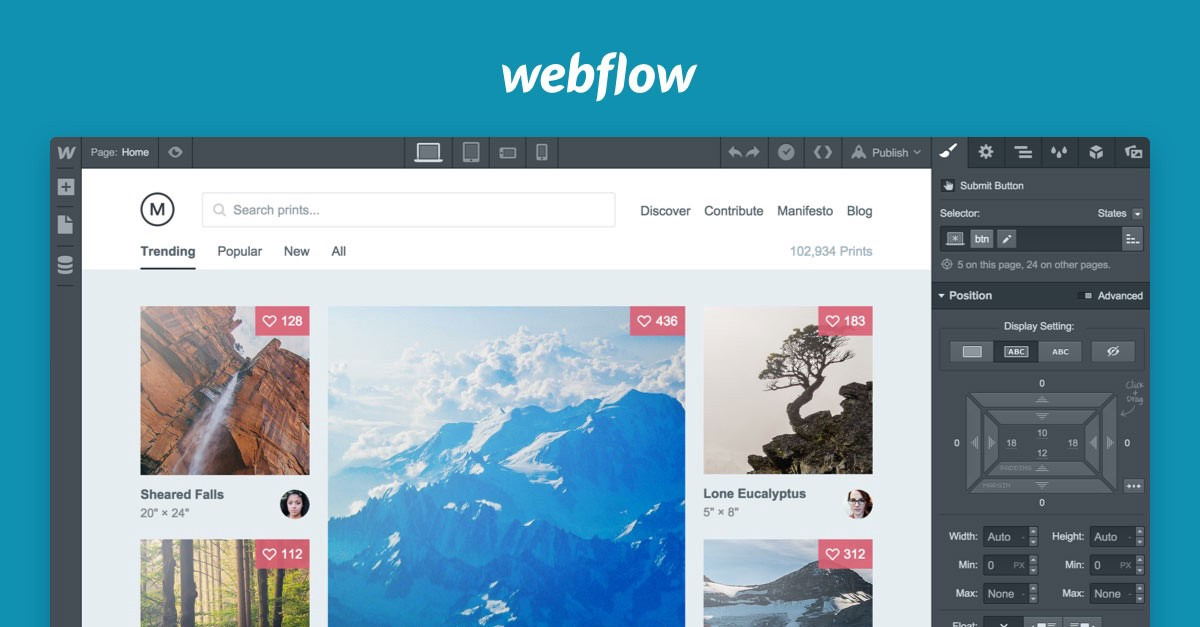
Webflow, launched in 2013, is a user-friendly tool designed for effortless custom responsive website creation, reducing the need for extensive coding. Its six core functions—CMS, Designer, Hosting, Interactions, Editor, and Ecommerce—empower users of all levels to build, manage, and enhance websites easily. Webflow’s intuitive, Photoshop-style editor streamlines the design process and includes hosting services, though it may have a learning curve for some.
Webflow offers a range of features, including customizable domain names, tailored navigation, and seamless e-commerce integration. It provides standard customer engagement tools like images, videos, and widgets. The platform smoothly integrates with Google Analytics, maintains a client support forum, and strongly emphasizes security through password-protected accounts.
However, it relies on external solutions for e-commerce, SEO, and newsletter functionalities. Users can also use multi-language options and ensure their websites are optimized for mobile devices.
A Detailed Review of Webflow

Pricing & Fees
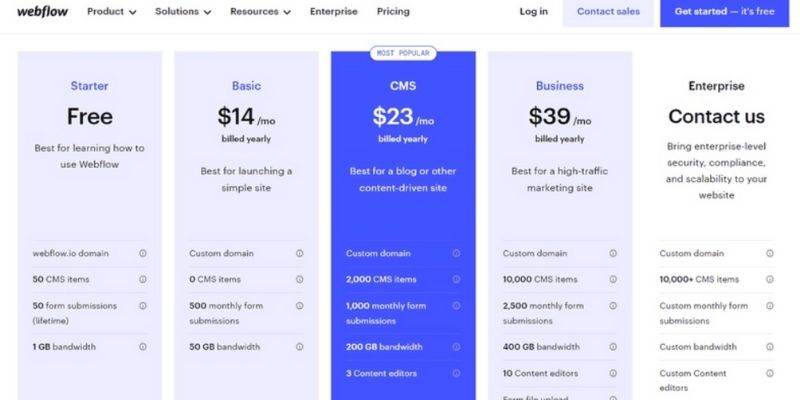
Webflow presents six pricing plans: three for websites and three for online stores, with the prices listed as monthly rates for annual subscriptions. There’s also a free plan for ad-free site building, but it comes with a webflow.io domain and lacks advanced design tools.
The most affordable paid option is the $14/month Webflow Basic plan, suitable for simple sites with standard elements like image galleries and contact forms. For blogs and content-driven sites, there’s the CMS plan at $23/month, while businesses looking to market and expand can opt for the $39/month Business plan.
Webflow’s ecommerce plans cater to various needs:
- Standard – $29/month
- Plus – $74/month
- Advanced – $212/month
For large enterprises, Webflow offers a custom Enterprise solution tailored to your needs, with a personalized quote and comprehensive support throughout site-building.
Ecommerce and Site Plans
Ecommerce plan
Webflow offers three ecommerce plans: Standard, Plus, and Advanced.
- Standard Plan: Ideal for businesses with approximately $50,000 in annual sales. It encompasses all CMS website plan features but incurs a 2% transaction fee. It was priced at $42.00 per month or $29.00 for a 12-month term, billed annually at $349.00.
- Plus Plan: Tailored for companies with around $200,000 in annual sales. It includes all Business Website Plan features, boasts a 0% transaction fee, and provides ten employee accounts. It was priced at $84.00 or $74.00 monthly for a 12-month term, billed annually at $888.00.
- Advanced Plan: The premier ecommerce plan with no annual sales or transaction fees. It encompasses all website features and offers 15 employee accounts. It is priced at $235.00 per month or $212.00 per month for a 12-month term, billed annually at $2,544.00.
Site plan
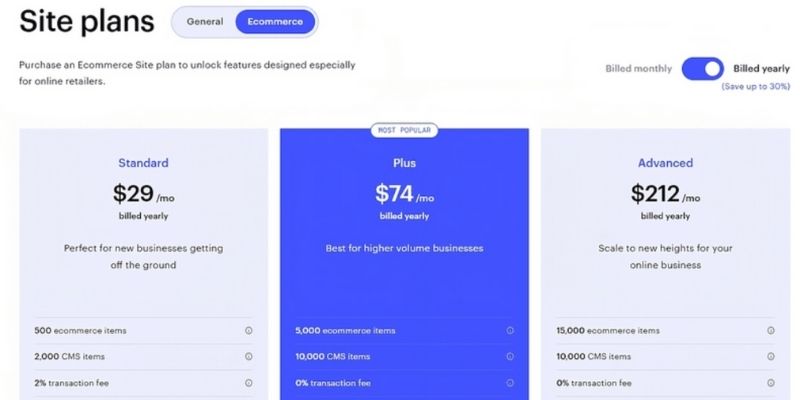
Webflow offers various pay-per-website plans, ideal for different project types, including personal blogs, business sites, and e-commerce ventures.
- Basic Website Plan: Suited for smaller websites without CMS features, with bandwidth for 25,000 monthly visitors. Priced at $15.00 per month or $12.00 per month for a 12-month term, billed annually at $144.00.
- CMS Website Package: Provides access to CMS features, accommodating up to 100,000 monthly visitors and offering three content editor credentials. Priced at $20.00 per month or $16.00 per month for a 12-month term, billed annually at $192.00.
- Business Website Plan: Designed for high-traffic business websites, supporting one million monthly visitors. Includes ten unlimited content editor logins and form submissions. Priced at $45.00 per month or $36.00 per month for a 12-month term, billed annually at $432.
Does Webflow have a money-back guarantee?
Webflow does not offer a money-back guarantee. They also do not refund. While this may seem like a big negative, we understand why the company works this way. Webflow lets you get started on projects for free. You can take advantage of website building tools and even check the quality of your hosting service without having to pay anything.
You can see if the service is right for you before you provide any billing information. This is a rather generous benefit that most companies don’t offer. The money-back-guarantee is meant to give you peace of mind when you don’t know what a carrier quality would be like. Because you can test all of that before, there’s no need for it.
User Experience and Interface
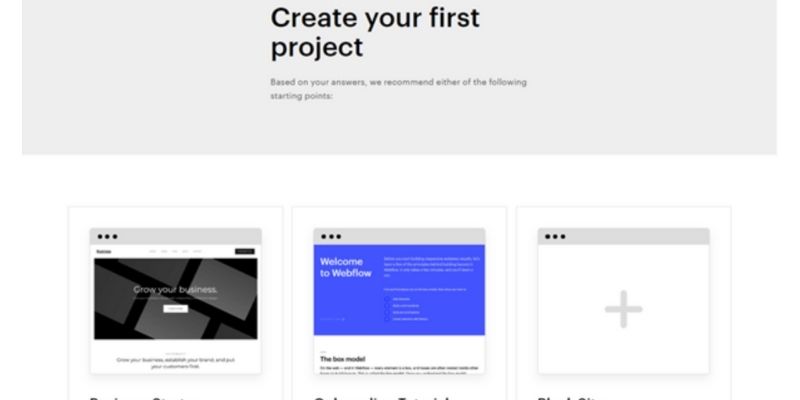
Webflow is considered not easy to use with either newbies or experts. From our experience with the builder, the editor required a level of knowledge above what we were comfortable with.
While it’s clear from user-generated content that you can do a lot with Webflow, we needed the web development knowledge to achieve it. We recommend Webflow’s tutorial to first-time users, but even then, more is required.
Templates & Design
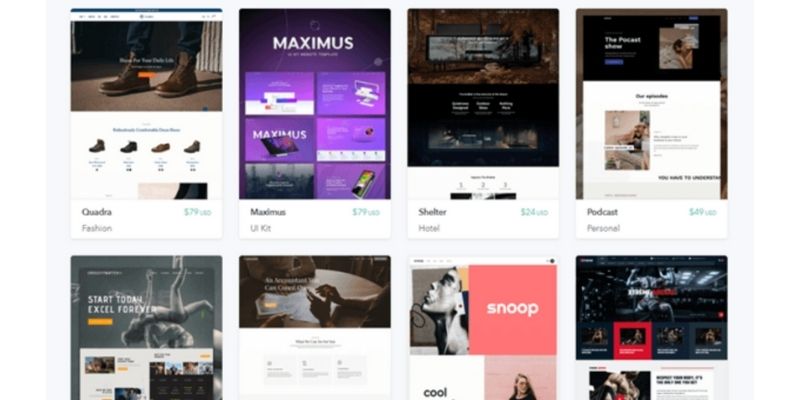
Webflow’s strength as a builder lies in its design capabilities. It has grown over time by adding more technical elements to its editor, earning it a high ranking for design functionalities.
- Number of templates: Webflow offers over 2000 templates, including 50 free ones, each with in-built animations and smooth page transitions.
- Quality of templates: In terms of design quality, Webflow’s templates are clean, responsive, and fully customizable, holding their own against market leader Squarespace.
- Availability of typefaces: Each template has a description, guiding you on its suitability and design possibilities.
- The behavior of templates on mobile: All Webflow templates are responsive, automatically adapting to diverse screen sizes.
- Switching templates in Webflow: You can easily filter templates by industry, pricing (free/premium), or ecommerce, simplifying the search for your ideal design with the ability to preview and identify dynamic content support.
Premium templates range in price from $19 to $149, which may sound steep, but as a one-off cost, it’s more of an investment. Webflow’s user-generated templates also provide users with additional choices for templates.
Webflow Hosting

When your website is perfect, you can publish through Webflow many hosting packages available. Now, starting the design and construction process is completely free. You can even publish your creations for testing purposes without paying a penny. This allows website owners to get a feel for the service for the first time and see what their website looks like. Free websites come with limited features and are published with .io subdomain.
Webflow’s real hosting takes things to the next level. As a hosting provider, Webflow doesn’t disappoint. Not only are there a number of plans to choose from, but you also get high-quality services that rival those of dedicated web hosting companies.
Webflow eCommerce features

Core ecommerce features in Webflow:
Webflow offers ecommerce capabilities, allowing you to create an online store and market your products. It’s important to note that Webflow imposes product limits, distinguishing it from ecommerce platforms like Shopify. Specifically, the Advanced plan accommodates a maximum of 15,000 products, while the Standard plan permits the sale of up to 500 products.
Ecommerce limits to watch out for:
Webflow’s Ecommerce platform, although relatively new, has quickly emerged as a strong competitor to giants like Squarespace. It simplifies website building with numerous templates at your disposal. You have full control over your online store, creating product grids, customized pages, shopping carts, and checkout experiences with unique graphics and animations.
Webflow eCommerce handles it on the technical front, from payment processing (credit cards, Apple Pay, Google Pay) to automated tax calculations. It integrates with Zapier for enhanced inventory management, enabling tasks like label creation and progress tracking.
Although the e-commerce platform may offer fewer features than some competitors, it’s essential to consider its relative novelty. Webflow envisioned it as a dynamic solution suitable for small business owners and larger enterprises, with potential for growth and adaptation.
SEO & Blogging
SEO
Search engine optimization, or SEO, is optimizing your website’s content to improve its ranking on search engines like Google and Bing. This can be done by adding or editing metadata, using image alt text, and targeting specific keywords. Webflow takes this a step further by automatically generating sitemaps and allowing you to create custom 301 redirects. This helps your site appear higher on search engine results pages.
Blogging
Webflow is one of the best blogging platforms, with an overall score of 3.5 out of 5. It offers excellent customization options and strong SEO capabilities for each page. However, its technical focus may make it easier for beginners to use. Webflow is a perfect choice for bloggers if you have some technical knowledge. If not, choose a platform with a higher ease-of-use score, such as Squarespace.
### Integrations with Apps
Webflow, like many top website builders, has its app store. However, unlike other platforms, Webflow’s add-ons are created by third parties rather than by Webflow itself. Many of these integrations are created by Webflow’s users through the “Made in Webflow” and “Libraries” features, which allow you to download and clone entire website templates or specific features created by other Webflow users.
Integrations with Apps
Webflow, like many top website builders, has its app store. However, unlike other platforms, Webflow’s add-ons are created by third parties rather than by Webflow itself. Many of these integrations are created by Webflow’s users through the “Made in Webflow” and “Libraries” features, which allow you to download and clone entire website templates or specific features created by other Webflow users.
Webflow Support Review

Webflow offers a range of helpful tutorials and guides through its online resource, Webflow University. Here, you can find information on everything from platform use to specific integrations. The help center is well-organized and easy to search, making it a great first stop if you need assistance.
If you need help finding what you’re looking for in the help center, you can also visit Webflow’s community forum. Here, users share their experiences and discuss the platform, so someone else has likely encountered the same issue you’re facing.
However, contacting Webflow directly can be challenging. The platform does not offer phone or live chat support, so email is the only way to contact you. Webflow’s response team is available from 6 a.m. to 6 p.m. PT, Monday through Friday, and you can expect a personal reply within 24-48 hours.
Webflow Competitors
Wix
- Ease of Use: Wix is known for its user-friendly drag-and-drop website builder, making it accessible to beginners. It’s a strong competitor in terms of ease of use.
- Features: Wix offers a wide range of features, including an app market for added functionality. It suits various website types, from simple portfolios to e-commerce sites.
- Pricing: Wix provides free and premium plans with competitive pricing. It’s budget-friendly for small businesses and individuals.
- Support: Wix offers extensive customer support options, including 24/7 live chat. This is beneficial for users who require immediate assistance.
- Who is it Best For?: Wix is best for beginners, small businesses, and individuals who want an easy-to-use website builder with various features and solid support.
HubSpot CMS Hub
- Ease of Use: HubSpot CMS Hub is designed for marketers and offers user-friendly content management and marketing automation tools.
- Features: It’s rich in marketing and SEO features, making it ideal for businesses focused on inbound marketing and lead generation.
- Pricing: HubSpot CMS Hub tends to be on the higher end in pricing, which may be suitable for mid-sized to large businesses with specific marketing needs.
- Support: HubSpot provides comprehensive support and training resources to help users maximize its marketing capabilities.
- Who is it Best For?: HubSpot CMS Hub is best for marketing-focused businesses looking to integrate content management and inbound marketing strategies.
Duda
- Ease of Use: Duda offers a user-friendly website builder with a strong focus on mobile responsiveness.
- Features: It provides a range of features, including e-commerce capabilities and multilingual support, making it suitable for small to mid-sized businesses.
- Pricing: Duda offers competitive pricing with different plans. It’s budget-friendly for businesses looking for a mobile-first approach.
- Support: Duda offers customer support options, though not as extensive as some competitors.
- Who is it Best For?: Duda is best for businesses seeking a mobile-responsive website builder with e-commerce capabilities and small businesses with budget constraints.
Framer
- Ease of Use: Framer is a design tool with a steeper learning curve, catering to design professionals who want to create interactive prototypes.
- Features: It excels in interactive design and prototyping, making it ideal for designers and teams focused on creating highly interactive web experiences.
- Pricing: Framer offers various pricing plans, including a free option. However, it may be more suitable for design-focused professionals or agencies.
- Support: Framer provides customer support and resources but may not have as extensive support options as competitors.
- Who is it Best For?: Framer is best for design professionals and teams looking to create interactive prototypes and web experiences.
WordPress.com
- Ease of Use: WordPress.com offers a user-friendly content management system (CMS) suitable for bloggers and small businesses.
- Features: It has a vast library of plugins and themes, making it adaptable to various website types, from blogs to e-commerce sites.
- Pricing: WordPress.com offers a range of plans, including a free option. It’s budget-friendly for individuals and small businesses.
- Support: Support options vary depending on the plan, with higher-tier plans offering more comprehensive support.
- Who is it Best For?: WordPress.com is best for bloggers, small businesses, and individuals seeking a versatile CMS with a wide array of plugins and themes. In summary, each of these competitors has its strengths and is suited for different purposes. The choice should depend on your specific needs, budget, and level of expertise, whether you prioritize ease of use, marketing features, mobile responsiveness, interactive design, or content management capabilities.
Who Should Use Webflow?
Webflow is a powerful web design platform that allows users to create and publish responsive websites without coding. Webflow is suitable for various users, depending on their needs and goals. Here are some examples of who should use Webflow and why:
- Solopreneurs: For solo entrepreneurs looking to launch an online business, Webflow offers a versatile platform with templates, CMS, ecommerce, and hosting features to create a professional website quickly.
- Small Business Owners: Small companies benefit from Webflow’s tools for crafting sites that reflect their brand identity, with integrations, forms, animations, and interactions to engage customers effectively.
- Freelance Web Designers: Freelance web designers can streamline their workflow and deliver high-quality websites faster using Webflow’s visual editor, code export, client billing, and collaboration tools.
- Web Design Agencies: Web design agencies can scale efficiently with Webflow’s team plans, white labeling, project transfer, and client feedback features, enabling them to handle multiple projects with control and flexibility.
- Large Brands and Tech Companies: Large brands and tech firms can meet their high standards using Webflow’s enterprise plans, custom domains, SSL certificates, CDN, and security features to create fast, secure, and reliable websites.
Webflow FAQs
Read more:
- Shopify Pricing Plans
- Shopify vs Squarespace Compared
- Silkroad Dropshipping review
- Shopify Reviews for 2021: Pros and Cons
- Shopify vs BigCommerce: A Comprehensive Comparison
- 3dcart vs Shopify Compared
Conclusion
For experienced designers and developers, you might just like Webflow. In the website builder that is accessible to the code, but without it, you have options for all sizes and sizes of your business website. As for Advanced eCommerce, it seems acceptable if you can integrate external tools, extensions, and plugins to get the results you need.
Beginners will probably struggle with Webflow unless they’re happy with a free account and one of Webflow’s limited templates, but the real price tag for more premium sites needs them to do more. New users looking to set up a website quickly and easily should consider another class of website builders and there are plenty of people in the market.
Webflow has the potential for custom websites by advanced web designers looking for a code-free experience, but it can also be flexible to add and edit code. If you’re looking for a more advanced platform, Webflow is one of the few DIY options in the class. Depending on your needs and experiences, Webflow can be a good solution. A free Starter account is the best way to check it out.
New Posts






